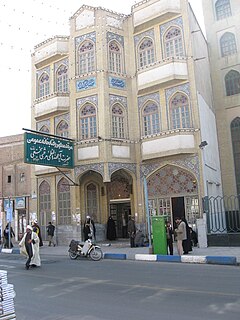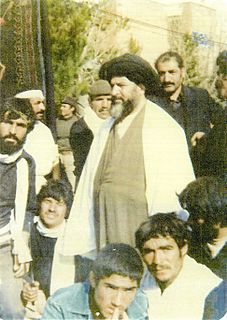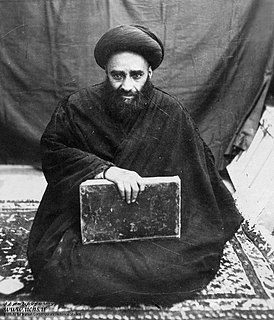
Ayatollah or ayatullah is a high-ranking Usuli Twelver Shī‘ah cleric. Those who carry the title are experts in Islamic studies such as jurisprudence, Quran reading, and philosophy and usually teach in Islamic seminaries. The next lower clerical rank is Hujjat al-Islam.

Muhsin al-Hakim (1889–1970) was born into a family, the Tabatabaei, renowned for its scholarship. He became the sole Marja' in 1961 after the death of Grand Ayatollah Sayyid Husayn Borujerdi. His son Abdul Aziz al-Hakim was the leader of SIIC the largest political party in Iraq.

Grand Ayatollah Sayyid Muhammad Saeed al-Tabataba'i al-Hakim is an senior Iraqi Twelver Shi'a marja, one of the Big Four Grand Ayatollahs of the Hawza of Najaf and one of the most senior Shia clerics in Iraq after Ayatollah Ali al-Sistani.

Grand Ayatollah Sheikh Basheer Hussain Najafi is a Twelver Shia Marja' and one of the Big Four Grand Ayatollahs of Najaf, Iraq. He was born in Jalandhar, a city in then British India. After the independence of Pakistan in 1947, his family moved to Pakistan and settled in the city of Gujranwala, Punjab. In Gujranwala he had his initial education in religion. He was then able to move to Iraq for studies in the early 1960s. He is one of many individuals from South Asia and one of the few Pakistanis to have ever been elevated to the highest rank of Grand Ayatollah in Shia Islam. He was one year senior to Grand Ayatollah Ali Sistani.

Grand Ayatollah Lotfollah Safi Golpaygani is one of the most senior Twelver Shia Marja living in Iran after Ali Khamenei. He was born in Golpaygan, Iran. He has studied in seminaries of Qom, Iran under Grand Ayatollah Borujerdi. He currently resides and teaches in the Seminary of Qom, Iran. He is a supporter of the Islamic revolution in Iran and is known for his fatwa calling for the death of rapper Shahin Najafi for apostasy.

Ayatollah Mirza Jawad Tabrizi was an Iranian Twelver Shi'a Marja'. He was born in Tabriz, Iran in 1926 AD. At 22 he moved to Qom and later to Najaf, Iraq until he was deported. He then moved back to Qom and was a teacher in the hawza of Qom until his death. He died in Qom, Iran in 2006 AD.

Grand Ayatollah Allama Shaikh Muhammad Hussain Najafi is a Pakistani Twelver Shia Marja. At the present there are two maraji of Pakistani descent, the first one is Basheer Hussain Najafi and second one is he himself. As Basheer Hussain Najafi has chosen to reside in Najaf, Iraq, Muhammad Hussain Najafi is the only marja in Pakistan. He is running Hawza in Sargodha.
He has been included in the last 5 editions of "The Muslim 500: The World's Most Influential Muslims" since 2010. He is one of the 9 marja's mentioned in the most recent edition.
Kitab al-Makasib or Makasib is a two-volume Twelver Shi'ah legal manual of Islamic commercial law written on Fiqh by Morteza Ansari. It remains a key textbook in the modern Hawza and has been the subject of numerous commentaries. Makasib and the notable work of Akhund Khorasani, Kefayah al-osul, are taught in advanced classes at the seminaries. This book is one of the resources for the examination of the Assembly of Experts.

Grand Ayatollah Taqi Tabatabaei Qomi was an Iranian Twelver Shia Marja'.

Ayatollah Syed Ali Naqi Naqvi, born 1970 is one of the ayatollahs of Pakistan. His father, Allama Syed Safdar Hussain Najafi, was the principal of Hawza Elmiye Jamia-tul-Muntazar Lahore, the largest Shia madrasah in Pakistan.

Maulana Syed Safdar Hussain Najafi was a scholar and leader of Islam.

The Qom Seminary is the largest Islamic seminary (hawza) in Iran, established in 1922 by Grand Ayatollah Abdul-Karim Haeri Yazdi in Qom.

The Ayatollah Marashi Najafi Library, in Qom, is the third largest library in Iran, after the Central Library of Astan Quds Razavi, and the Library of Parliament, as well as being the world's third largest Islamic library, with more than 250,000 books, 25,000 of them online.
The Hakim family is a prominent family of Shiite Islam scholars who claim descent from the Prophet Muhammad. Their scholarly involvement has revolved around Iraq for centuries. The family faced extensive persecution and executions at the hand of Saddam Hussein's government, yet it maintains a prominent role in Iraq and the Middle East.

Grand Ayatollah Seyyed Mohammad Bagher Movahed Abtahi was a Shia Marja', Islamic scholar and author.

Sayyed Muhammad Hojjat KouhKamre'i was a Shia jurist and scholar in the principles of Islamic jurisprudence, hadith studies and narration studies. He was a Grand Ayatollah (marja') among Shia and founded the Hojjatiyyah School in Qom.

Grand Ayatollah Hajj Sheikh Abdolkarim Haeri Yazdi was a Twelver Shia Muslim cleric and marja. He was known as the founder of an important Islamic seminary (hawza) in Qom, Iran, and for his "studied disinterest in politics". Among his students was Ruhollah Khomeini.

The Najaf Seminary, also known as the ḥawza ʻilmiyya Najaf, is one of the two most important Shia seminaries (hawza), situated in the city of Najaf, Iraq, near the Imam Ali Mosque. It was established in the 11th century by Grand Ayatollah Shaykh al-Tusi.























